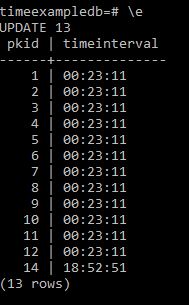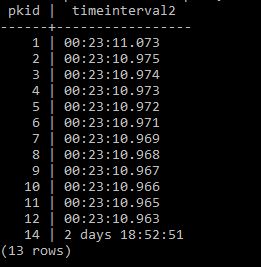An investigation of ranking / the timestamp variable the time variable and the interval variable.
Hours minutes and seconds
Hours minutes and tenths of seconds
Hours minutes and hundredths of seconds
Hours minutes and thousandths of seconds
So to highlight the examples I will first create a databsae called timeexampledb
CREATE database timeexampledb;
Now lets connect to that database
\c timeexampledb
Now I create a table called timebucket that will hold examples of the different time formats.
create table timebucket (pkid serial primary key, time1secondonly timestamp(0), time2tenthsecond timestamp(1), time3hundredthsecond timestamp(2), time4timethousandthsecond timestamp(3));
Next input some examples and see what we get.
insert into timebucket values (1, now(),now(),now(),now()); insert into timebucket values (2, now(),now(),now(),now()); insert into timebucket values (3, now(),now(),now(),now()); insert into timebucket values (4, now(),now(),now(),now()); insert into timebucket values (5, now(),now(),now(),now()); insert into timebucket values (6, now(),now(),now(),now()); insert into timebucket values (7, now(),now(),now(),now()); insert into timebucket values (8, now(),now(),now(),now()); insert into timebucket values (9, now(),now(),now(),now()); insert into timebucket values (10, now(),now(),now(),now()); insert into timebucket values (11, now(),now(),now(),now()); insert into timebucket values (12, now(),now(),now(),now()); insert into timebucket values (14, now(),now(),now(),now());
and lets see what that looks like
Here you can see from the tenth of a second options where you hit right on a second then a digit will disappear.
Now we can do ranking on these to determine position.
Select pkid, time1secondonly, rank() over wn as rank from timebucket window wn as (order by time1secondonly) order by time1secondonly;
This results in
So lets change this to rank the next column along.
Select pkid, time2tenthsecond, rank() over wn as rank from timebucket window wn as (order by time2tenthsecond) order by time2tenthsecond;
Appears to be working but lets try the other columns.
Select pkid, time3hundredthsecond, rank() over wn as rank from timebucket window wn as (order by time3hundredthsecond) order by time3hundredthsecond;
Appears correct but for good measure thousandths of a second.
Select pkid, time4timethousandthsecond, rank() over wn as rank from timebucket window wn as (order by time4timethousandthsecond) order by time4timethousandthsecond;
And now lets add an interval column
Alter table timebucket add column timeinterval time(0);
But lets add a further time5 column that and update to now time so we can create some intervals
Alter table timebucket add column time5 timestamp(0); Update timebucket set time5 = now();
Now if we want to get the time between items we can make the following SQL
Select pkid, time5, time1secondonly, time5-time1secondonly as tinterval from timebucket;
And we get
Lets try with a different time column
Select pkid, time5, time4timethousandthsecond, time5- time4timethousandthsecond as tinterval from timebucket;
So next I reduce pkid record 14 by a day and re run to see what happens.
Update timebucket set time4timethousandthsecond='2019-12-04' where pkid=14;
and run the former select again;
Select pkid, time5, time4timethousandthsecond, time5- time4timethousandthsecond as tinterval from timebucket;
and we see the interval is correctly recording.
Now if we want to rank on tinterval I was unable to do it directly from a query so I went ahead and updated the former timeinterval column as follows
update timebucket set timeinterval=time5-time4timethousandthsecond;
and now doing a select on this we get
select pkid, timeinterval from timebucket;
What we see is
But we are not showing the fact that 14 should be 1 day this is because we should have defined timeinterval as an interval variable rather than a time(0) variable.
So we can do this as follows and update appropriately.
Alter table timebucket add column timeinterval2 interval; update timebucket set timeinterval2=time5-time4timethousandthsecond; select pkid, timeinterval2 from timebucket;
And we get the right result
And now lets rank these to check it is sorting them correctly.
Select pkid, time4timethousandthsecond, timeinterval2, rank() over wn as rank from timebucket window wn as (order by timeinterval2) order by rank;
And we get the correct result











